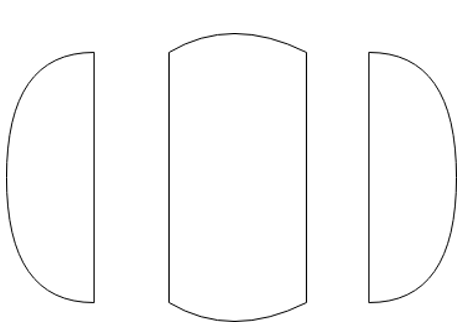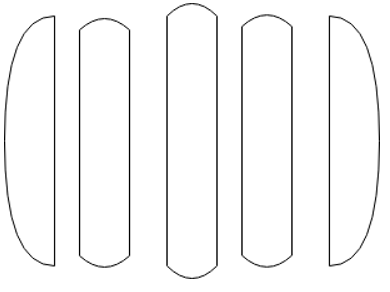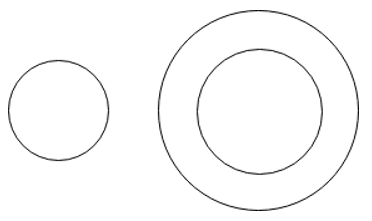This set of Heat Transfer Operations Questions and Answers for Experienced people focuses on “Tube Heat Exchangers – Heat Transfer Area, Tube Diameter, Length and Tube Arrangements”.
1. In a shell and tube heat exchanger, the heat transfer area is maximum for ________
a) Concurrent
b) Counter current
c) Concurrent at a part and Counter current at the other
d) Mixed flow
View Answer
Explanation: In a shell and tube HE when the fluids are flowing in their respective paths, the LMTD is minimum for Concurrent flow hence for a particular temperature change, area is maximum.
2. If the Heat Transfer area for a Shell and tube heat exchanger is 15000mm2, and the radius of the tubes is 30mm, then what is the length of the tubes required?
a) 16cm
b) 15.9cm
c) 13cm
d) 15cm
View Answer
Explanation: Given the area is 15000mm2, we have the heat transfer area in terms of the tube diameter as A = πDL = 15000mm2 or L = 15000/3.14×30 = 159 mm = 15.9cm.
3. If the Heat Transfer area for a Shell and tube heat exchanger is 15100mm2, and the radius of the tubes is 30mm, then what is the number of hairpins required if its single pass length is 4cm?
a) 1
b) 2
c) 3
d) 4
View Answer
Explanation: Given the area is 15100mm2, we have the heat transfer area in terms of the tube diameter as A = πDL = 15100mm2 or L = 15100/3.14×30 = 160 mm = 16cm. As the length of a single pass hairpin is 4cm, its length is 8cm, hence we require n = 16/8 = 2hairpins.
4. What are the ways can tubes be arranged in a shell and tube HE?
a) Half parallel flow arrangement & Semi parallel flow arrangement
b) Hairpin arrangement & Full parallel flow arrangement
c) Full parallel flow arrangement & Half parallel flow arrangement
d) Hairpin arrangement & Half parallel flow arrangement
View Answer
Explanation: In a shell and tube HE, we can arrange the tubes in two different ways; they are (i) Hairpin arrangement, (ii) Full parallel flow arrangement.
5. Why do we provide baffles? Choose the option that is incorrect.
a) To support the tubes
b) To increase turbulence in the shell side
c) Sometimes behave as fins
d) Increases Heat transfer Coefficient
View Answer
Explanation: Baffles are specially provided to act as mechanical support to the tubes and increase the turbulence on the shell side. The consequence of this leads to an increase in the overall heat transfer coefficient.
6. Recognise the below baffle arrangement.

a) Double Segmental
b) Triple Segmental
c) Segmental
d) Doughnut Segment
View Answer
Explanation: A baffle is called double segmental when it is divided to three parts by using two segments as shown in the figure. These three parts are then placed at separate places at some distance to each other.
7. What is the number of baffles in the shell side if the baffle spacing is 6cm and Length of the setup is 90cm?
a) 15
b) 12
c) 14
d) 16
View Answer
Explanation: The number of baffles is defined as N, where N+1 = L/B = 90/6 = 15, hence N = 14.
8. What is the correct expression for the number of passes in shell side of a shell and tube HE?
a) L/B
b) L/B – 1
c) L/B + 1
d) B/L
View Answer
Explanation: The number of baffles required is given by N = L/B – 1. Hence the number of passes is equal to N + 1 = L/B. Thus the correct answer is L/B.
9. Doughnut shaped baffles are one of the commonly used baffles in the industry.
a) True
b) False
View Answer
Explanation: Baffles can be divided into three parts, segmental, doughnut and orifice. Thus all three of these baffles are widely used in the industries.
10. Recognize the following baffle arrangement

a) Double Segmental
b) Triple Segmental
c) Segmental
d) Doughnut Segment
View Answer
Explanation: This arrangement is called Triple segmental because it can be arranges in the shell in three different segments or regions inside the shell of the HE.
11. Recognize the following baffle arrangement

a) Double Segmental
b) Triple Segmental
c) Segmental
d) Doughnut Segment
View Answer
Explanation: This class of baffle is called doughnut baffle because of the segment which is made at the centre of the baffle and placed at two different regions at a particular distance to each other. These two parts are called doughnut and disc.
12. The number of possible baffles classification are______
a) Doughnut and disc baffles
b) Orifice and disc baffles
c) Segmental, Doughnut and Orifice baffles
d) Segmental, Doughnut and shell baffles
View Answer
Explanation: The three classes of baffles can be presented as: Segmental, Doughnut and Orifice baffles. The segmental baffles are further classified as double, triple, etc segmental.
13. If we desire to have 5 shell passes for a shell of length 40cm, what is the baffle spacing in the shell side?
a) 8cm
b) 7cm
c) 6cm
d) 5cm
View Answer
Explanation: The number of shell passes can be represented as: N = L/B or B = L/N = 40/5 = 8cm.
14. Shell and tube HE as well as baffle designs are made by strictly following the standards of______
a) TERA
b) AESA
c) TEMA
d) AISA
View Answer
Explanation: The design for baffles of a shell and tube heat exchangers are strictly made by following the standards of the Tubular Exchanger Manufacturers Association (TEMA).
Sanfoundry Global Education & Learning Series – Heat Transfer Operations.
To practice all areas of Heat Transfer Operations for Experienced people, here is complete set of 1000+ Multiple Choice Questions and Answers.
If you find a mistake in question / option / answer, kindly take a screenshot and email to [email protected]
- Apply for Chemical Engineering Internship
- Check Chemical Engineering Books
- Practice Chemical Engineering MCQs
- Check Heat Transfer Operations Books
